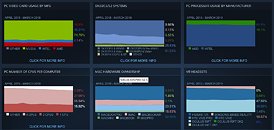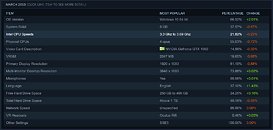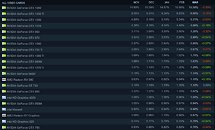Monday, April 8th 2019

Steam Hardware Survey Shows AMD's Continued Struggle to Gain Market Share
Steam's latest hardware survey has been released, and while there is no real head scratching changes, it does continue to give us a glimpse into current market trends. In regards to CPU adoption, both six-core and eight-core processors now account for 12.2% and 2.2% respectively. Looking at just Windows data shows six-core processors gained a bit over 2% market share in 3 months. Meanwhile, eight-core offerings saw a market share increase of roughly 0.5%. Speaking of processors, Intel still dominates the market capturing an 82% share. AMD, while competitive in many tasks besides gaming still only has an 18% share. Looking at the data would lead one to believe AMD is gaining back market share; however looking at previous hardware surveys their current share is mostly holding steady. Considering Intel still offers better gaming performance for the time being its unlikely AMD will make any real gains in the Steam hardware survey until gaming performance reaches true parity.
Looking at graphics cards, NVIDIA still reigns supreme holding the same 75% market share they have been clutching for quite some time. AMD, on the other hand, continues to struggle, holding a paltry 15% share with Intel and their integrated graphics still managing to hold a 10% share. Considering AMD's only release as of late was the Radeon VII it is not all that surprising to see no change here. That said, NVIDIA's dominance is indeed not a good thing as it means competition is minimal, and pricing is likely to remain high. Right now according to the Steam hardware survey, NVIDIA currently holds the first 12 spots in regards to today's most popular graphics cards, which combine for a 52.8% share. The most popular of these being the GTX 1060. You have to go all the way down to 13th place to find an AMD graphics card which just so happens to be the Radeon RX 580 with its 1.1% share. To find the next AMD graphics card you have to go all the way down to 19th where the companies Radeon R7 Graphics holds steady at 0.87%. Hopefully, AMD's upcoming Navi graphics architecture can bring them back to prominence and drive more competition.
Source:
Steam Hardware Survey
Looking at graphics cards, NVIDIA still reigns supreme holding the same 75% market share they have been clutching for quite some time. AMD, on the other hand, continues to struggle, holding a paltry 15% share with Intel and their integrated graphics still managing to hold a 10% share. Considering AMD's only release as of late was the Radeon VII it is not all that surprising to see no change here. That said, NVIDIA's dominance is indeed not a good thing as it means competition is minimal, and pricing is likely to remain high. Right now according to the Steam hardware survey, NVIDIA currently holds the first 12 spots in regards to today's most popular graphics cards, which combine for a 52.8% share. The most popular of these being the GTX 1060. You have to go all the way down to 13th place to find an AMD graphics card which just so happens to be the Radeon RX 580 with its 1.1% share. To find the next AMD graphics card you have to go all the way down to 19th where the companies Radeon R7 Graphics holds steady at 0.87%. Hopefully, AMD's upcoming Navi graphics architecture can bring them back to prominence and drive more competition.



91 Comments on Steam Hardware Survey Shows AMD's Continued Struggle to Gain Market Share
Your advice is true, but you have A LOT better chance of Intel to work off qvl than ryzen anything.
That said these lists arent updated half the time and memory mfg switch skus etc... so they arent The Gospel, but it is the best we have. :)
There is certainly a difference when it comes to support for overclocked memory, and the three main factors are memory controller, motherboard support and the specs of the memory module itself.
At the moment most Intel CPUs are rated for 2666 MHz, and many AMD CPUs 2933 MHz. Many gamers today buy memory kits rated for ~3200-3600 MHz, and Intel CPUs do certainly do better with overclocked memory, but very few are able to run them at such speeds over time. Skylake-family CPUs can't consistently hit even 3200 MHz, and even if you are able to POST on a good speed, you'll have to gradually clock down over time as the memory controller degrades. Memory overclocking is just as waste of time since it only gives marginal gains for most use cases, it causes many stability problems and so on. And not to mention that most buyers of fancy memory actually never realize they have to enable and calibrate overclocked memory to get any "gains". It's a waste of money unless your purpose is competitive benchmarking.
When you go and buy a memory kit, you should not match the rated max speed with your CPU, you should look at the SPD rating, which is the JEDEC speed it's guaranteed to work at. Most >=2666 MHz kits today have a SPD rating of 2133 MHz, which is the speed you will be falling back to. If your CPU is rated for 2666 MHz, then go buy a memory kit with SPD rating of 2666 MHz and it will work just fine, AMD or Intel, and you will actually get what you pay for.
There also isnt an issue on modern/current gen Intel runni g those speeds. I've had x299 and 3600 sticks since month 1... all good here...no issues on the web re mass degradation.
...the IMC is rated for the platform's base specification, be it 2400/2666/2933. Once over that, the IMC is being overclocked. The memory sticks themselves, however, are only considered overclock if it exceeds the rating on the box.... it really doesn't matter that most memory IC's are cut from 2133/2400. Their 'rated' speeds are on the box. :)
Brand A = 75%
Brand B = 12%
Brand C = 11%
To say that that data in no way represents the totality of professional baseball in the USA, you'd have to show that the factors that affect choice are somehow different between the two leagues. As there is no evidence to support that, the data is statistically valid with respect to GPUs.
Now for CPUs, we can make the argument that there are different choice factors, as business and many home users don't have discrete cards. However no one is suggesting that the Steam CPU data refelects anything but the gaming world so the postulation while valid is out of context. When limited to the gaming world ... and here we mean the folks playing games sold on Steam .... not Solitaire, Minesweeper and things like Yeti Games, there again is no evidence or reasonable argument to suggest that the factors that affect choice are different whether they be buying their games from Steam, Epic, GOG, Walmart or Best Buy. Might as well argue that sales data from 2,000 Macy's stores is not representative of sales of a particular product they both carry because it doesn't include Gimbels sales. Or that we can't depend upon relative sales of 1%, 2% and 4% milk cause it only included 50% of supermarket chains... what would be the argument that King Kullen shoppers prefer different milk than those who bshop at "Stop 'n Shop" ? Polls come away with single digit accuracy with just 2,500 samples.
Now if we go "out of context", and include business and mom / grandpappy's PCs, there are factors that affect choice are different for a this segment of purchasers. If ya want these, use a different data source. But still, these results will be skewed somewhat. For example, data from "who ran our benchmark" will be skewed as only someone who cares how fast the PC is will have bothered to run the benchmark. Grandma who uses her PC only to see pics of the grandkids, certainly didn't. Grandma also isn't here reading this forum.
This forum is an enthusiast PC users forum whose audience is PC Tweakers, Gamers and Power users. Steam is an information resource for gamers. So when reading this forum and a topic about steam users ... keep in mind that context. It's understood that we are not talking about what CPU / GPU grandma is choosing. Grandma didn't even choose. She walked into Walmart witha proce in mind and bought the one that the pimply HS Junior showed her. The guy who bought 12 PCs for the new Real Estate office doesn't even know what CPU he has and doesn't have a GPU. So it's not that this information isn't available ... it's just of little value to those who would bother looking at the Steam Survey or this audience. It's not as if I'm building a high end gaming rig, what CPU my local bakery, lawyer's secretary or grandmother uses. If you are running a racing tem, do you really care about what brand of oil is most popular at Walmert ? (Answer to rhetorical question ... the one that's on sale) ... or are going to look at what brand most racing teams (successful ones) are running with.
Personally I really don't care what brand is selling the most .... how i find the data useful for example is when I see the 2060 with it's 1st appearance in the rankings has more sales than vega 56 & 64 combined after 17 months, I can only conclude a) there must be helluva reason or b) the entire gaiming community is stoopid. If coming in cold out of touch with what's what at this point, I'm not saying that makes my decision, but it wil narrow down what I look at.The box, which will typically advertise XMP speed, is irrelevant. When you look at the SPD data for RAM, each column that says JEDEC at the top is, by definition, not overclocked. If it says XMP (or AMD equivalent) it is 'by definition" overclocked even though it has the XMP speed "on the box"
www.intel.com/content/www/us/en/gaming/extreme-memory-profile-xmp.html
For a stick, anything over the highest JEDEC rating is an OC. For the MoBo... just look at the specs, regardles of what it says on the Box, the latest BIOs or spec sheet will tell you what is and what is not OC
www.newegg.com/Product/Product.aspx?Item=N82E16813144212
Everything that says OC is an overclock
Memory Standard: DDR4 4400(OC)/ 4300(OC)/ 4266(OC)/ 4200(OC)/ 4133(OC)/ 4000(OC)/ 3866(OC)/ 3733(OC)/ 3600(OC)/ 3466(OC)/ 3400(OC)/ 3333(OC)/ 3300(OC)/ 3200(OC)/ 3000(OC)/ 2800(OC)/ 2666/ 2400/ 2133
Either way ... unless it's been updated, this is the DDR4 JEDEC timing table.... anything higher than this is "by definition" an overclock. Overclocked does not mean "unsupported". Intel supports and guarantees all XMP overclocks.
pics.crucial.com/wcsstore/CrucialSAS/images/campaigns/c3-speed-vs-latency-table.png
Separate church (processor imc stock and oc) and state (what memory sticks are rated for vs programmed for compatibility/base spec). :)
All motherboards list "OC" on anything past platform spec because it isnt guaranteed and is overclocking the IMC. If it wasn't there people would think they could drop in anything and just run it those speeds. The sticks themselves come out of the box specd to run the speeds and the the motherboard supports it...they just need an IMC good enough to do so. THAT isnt a given. Only the processor/platform spec, and nothing more, is guaranteed. The sticks are guaranteed to run the speed on the box while having JEDEC specs for compatibility purposes.
Let's look at some random examples;
Corsair CMV16GX4M1A2666C18, this one is certified to run at 2666 MHz 1.2V. It should work on any DDR4 2666 MHz compliant IMC.
G-Skill F4-3200C16Q2-128GTZ, this one advertises 3200 MHz, but only guarantees a lousy 2133 MHz. If these specs are accurate and it doesn't have higher JEDEC profiles than this, then it's a very bad deal.
JEDEC profiles are the ones to use unless you have a good reason not to.
The JEDEC spec is listed for compatibility reasons, yes. The sticks are rated to run at the XMP profiles speed. That does NOT mean the sticks are overclocked because they are above platform/JEDEC specifications. Again separate church from state. The IMC and its rating versus what the sticks are rated for on the box/XMP and its compatibility (JEDEC/SPD) profiles.Correct. Those sticks are rated for 2666 on the box.Where do you see it only guarantees 2133? That is the SPD/JEDEC profile for compatibility. It has the XMP profile and is rated for 3200 MHz............again, assuming your board and IMC on the processor can handle this. The sticks can.. they are tested and certified to do so by the company...hence the label on the box.Huh? Why? There aren't any JEDEC/SPD profiles over platform (IMC) spec. How would I run the higher memory speeds if I didn't use the XMP profile/what the sticks are actually rated for??
EDIT: I don't know if a mod wants to split this off topic discussion out or what.............................